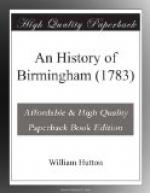But perhaps the artist had another grand scheme in view, that of accommodating the town with the additional harmony of the chimes; for only a few tunes can be played on the octave, whilst the dozen will compass nearly all.
Whether we are entertained even by this exalted style of music, admits a doubt; for instead of the curious ear being charmed with distinct notes, we only hear a bustle of confused sounds, which baffle the attention too much to keep pace with the tune.
These two steeples, are our public band of music: they are the only standing Waits of the place. Two thousand people may be accommodated in the church, but, at times, it has contained near three thousand.
In the vestry is a theological library, bequeathed by the first rector, William Higgs, for the use of the clergy in Birmingham and its neighbourhood; who left 200_l_. for future purchase.
Under the centre isle runs a vault, the whole length of the church, for the reception of those who chuse to pay an additional guinea.
The organ excels; the paintings, mouldings and gildings are superb: whether the stranger takes an external or an internal survey, the eye is struck with delight, and he pronounces the whole the work of a matter. Its conveniency also, can only be equalled by its elegance.
In the FRONT GALLERY.
Upon application of Sir Richard Gough, to Sir Robert Walpole, then in power, George the First gave 600_l_. in 1725, towards finishing this church.
Three remarks naturally arise from this declaration; That the prodigious sums expended upon this pious undertaking, were beyond the ability of the inhabitants; that the debts contracted, were many years in discharging; and that one of the best of Kings, the head of the Brunswick line, bestowed a liberal benefaction upon a people not compleatly reconciled to his house.
Whether monumental decoration adds beauty to a place already beautiful, is a question. There are three very small and very elegant monuments in this church. Upon one of the south pillars, is that of the above William Higgs, who died in 1733. Upon another is that of William Vyse, the second rector, who died in 1770, at the age of 61. And, upon a north pillar, that of Girton Peak, Esq; an humane magistrate, who died in 1770, aged 48.
Internment in the church is wisely prohibited; an indecency incompatible with a civilized people. The foreigner will be apt to hold forth the barbarity of the English nation, by observing, “They introduce corruption in their very churches, and pay divine adoration upon the graves of their ancestors.”
Places of worship were designed for the living, the dead give up their title with their life: besides, even small degrees of putrefaction, confined in a room where the air cannot circulate, may become prejudicial to health: it also ruins the pavement, as is done at St. Martin’s. Our first inhabitants, therefore, lie contented in the church yard, by their unfortunate equals; having private sepulchres appropriated for family use—Perhaps at the last day, no inquiry will be made whether they lay on the in, or the outside of the walls.




